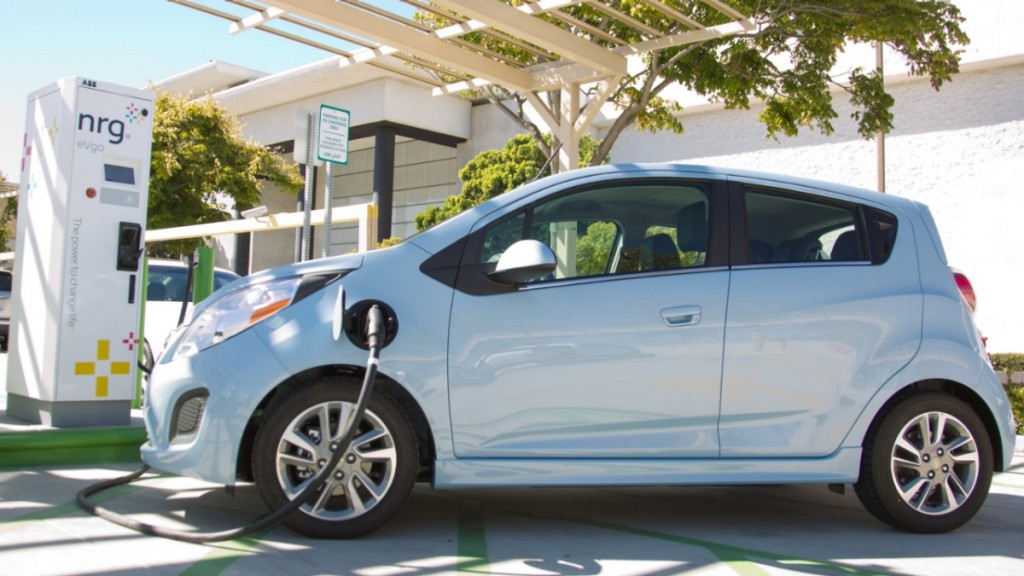Five years ago, a frequent matter of debate here at Green Car Reports was whether CCS or ChAdeMO would become the electric-car DC fast-charging standard of choice in the U.S.
Soon after that it became quite clear that CCS, with the weight of the European and U.S. auto industry behind it—and then the Korean industry joining later—was going to win.
And yet today, when you look at the actual numbers, as tallied by the U.S. government’s Alternative Fuels Data Center, you’ll find that even now, in the second half of 2019, there are still more places to fast-charge CHAdeMO vehicles than those with CCS.

CHAdeMO, CCS, and Supercharger - Alternative Fuels Data Center, Aug. 20, 2019
As of August 20, 2019, there are 2,140 charging stations and 3,010 connectors with CHAdeMO fast charging. CCS still lags behind CHAdeMO in the number of stations by more than 250, while it has about 500 more connectors. And Tesla has 678 Supercharger locations with 6,340 connectors. The Nissan Leaf lineup is the only one still on the market to primarily use the CHAdeMO standard.
When the first Combined Charging System (CCS) fast charging station finally arrived in the U.S. in October 2013, it was a couple of years behind the rollout of stations using the CHAdeMO standard championed by Japanese automakers and more than a year behind the first Tesla Superchargers.
In 2014 and 2015, Europe stormed ahead with CCS fast-charging infrastructure, and essentially moved to make it the dominant standard, while the U.S. lagged behind in deploying the hardware.

Chevrolet Spark EV at CCS fast charging station in San Diego.
Although the 2014 Chevrolet Spark EV was the first model available in the U.S. with CCS, GM stubbornly maintained that it wouldn’t fund CCS fast-charging sites for its Chevrolet Bolt. Meanwhile, Nissan helped subsidize the growth of a CHAdeMO network. So had early federal and state funding to build “electric highways” with carefully spaced fast chargers, that had been approved (and in some cases completed) before CCS even existed.
Part of the reason why CCS hasn’t gained ground is that, as called out in the Partial Consent Decree of the Volkswagen diesel settlement, Electrify America has to future-proof its stations by operating across different charging standards. Therefore, all public-facing fast chargers will include a CHAdeMO connector—just one, in most cases, running at 50 kw instead of the CCS connectors’ 150 kw or 350 kw.
It’s unlikely that CCS will take the lead for stations/locations this decade. Nationally, Electrify America’s Cycle 2 plan anticipates that just 40 to 50 of about 215 new 150-kw and 350-kw DC fast chargers will be operational by the end of 2019. Meanwhile, under an EVgo plan to install more 100-kw CHAdeMO hardware—jointly announced with Nissan earlier this month, will keep nudging both ahead, as that hardware will also be CCS-compatible.

Tesla Model S with CHAdeMO adapter
U.S. Tesla drivers also can opt for a CHAdeMO adapter, for access to those stations, which tend to be better-located for urban and suburban charging—as opposed to Tesla’s chargers, which tend to be at strategic points for road-trip potential.
Tesla drivers are again the winners. If it weren’t for the terms of the diesel settlement, Nissan and others might not have kept expanding the CHAdeMO network. Add the two standards together and Tesla owners have 2,818 charging locations and 9,350 connectors.
The higher-power CCS chargers (350 kw especially) will start influencing the market more eventually. But in this era of accessibility and cross-compatibility, it's now looking like both standards will be around for a long time.













